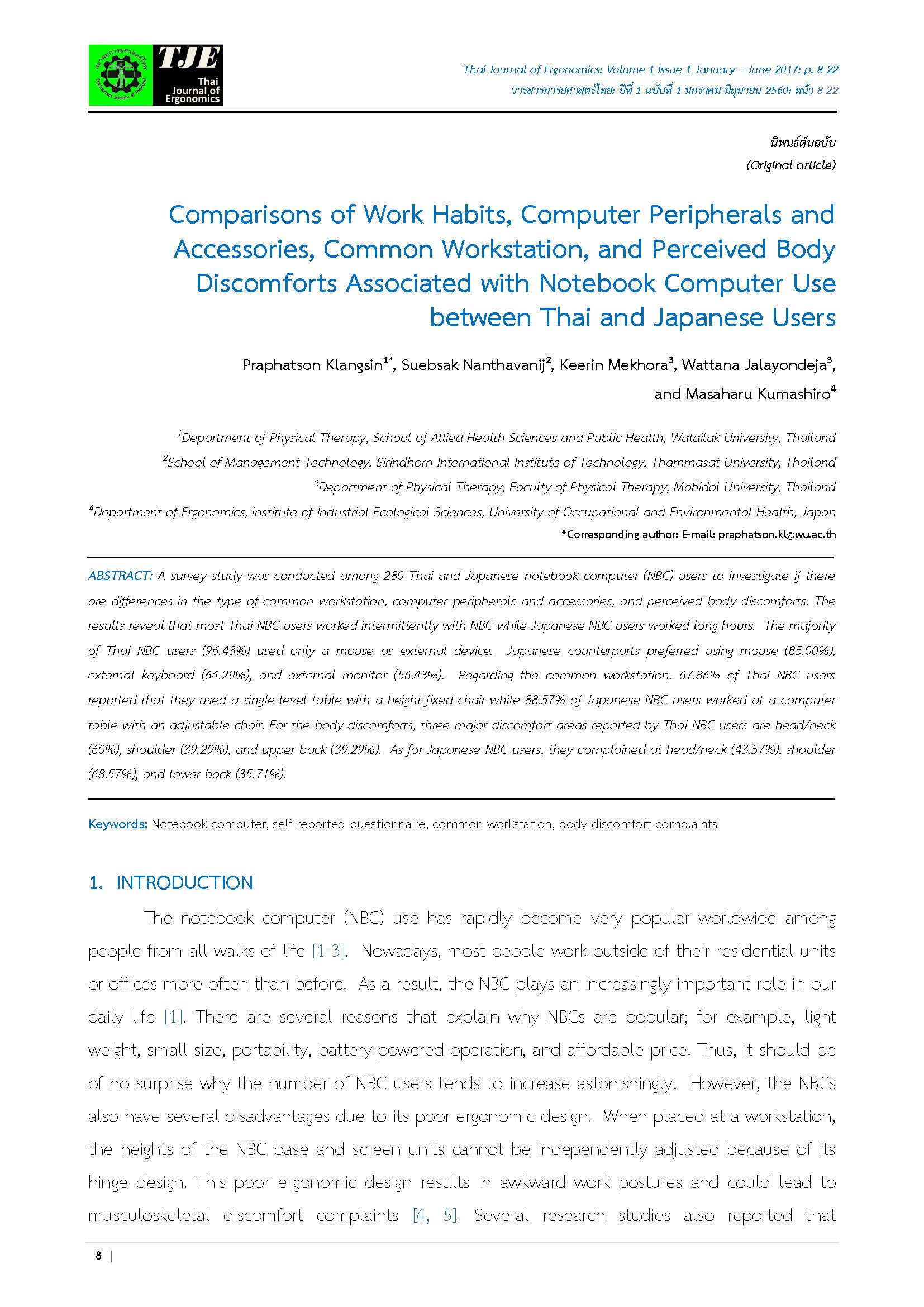Comparisons of Work Habits, Computer Peripherals and Accessories, Common Workstation, and Perceived Body Discomforts Associated with Notebook Computer Use between Thai and Japanese Users
Main Article Content
Abstract
A survey study was conducted among 280 Thai and Japanese notebook computer (NBC) users to investigate if there are differences in the type of common workstation, computer peripherals and accessories, and perceived body discomforts. The results reveal that most Thai NBC users worked intermittently with NBC while Japanese NBC users worked long hours. The majority of Thai NBC users (96.43%) used only a mouse as external device. Japanese counterparts preferred using mouse (85.00%), external keyboard (64.29%), and external monitor (56.43%). Regarding the common workstation, 67.86% of Thai NBC users reported that they used a single-level table with a height-fixed chair while 88.57% of Japanese NBC users worked at a computer table with an adjustable chair. For the body discomforts, three major discomfort areas reported by Thai NBC users are head/neck (60%), shoulder (39.29%), and upper back (39.29%). As for Japanese NBC users, they complained at head/neck (43.57%), shoulder (68.57%), and lower back (35.71%).
Article Details

This work is licensed under a Creative Commons Attribution-NonCommercial-NoDerivatives 4.0 International License.
References
Bangkokbiz newspaper on Sep 12, 2008. (accessed 4 April 2011).
Manager newspaper on April 6, 2011. (accessed 6 April 2011).
http://www.japanfs.org/en/mailmagazine/newsletter/pages/027789.html (accessed 27 May 2011).
Chiou WK, Chou WY, Chen BH. Notebook computer use with different monitor tilt angle: effects on posture, muscle activity and discomfort of neck pain users. Work. 2012;41:2591-5.
Raps T, Nanthavanij S. Survey study of notebook computer use and preferred work postures among Thai university students. Thammasat. Int. J. Sc. Tech. 2008;13:62-75.
Mekhora K, Liston CB, Nanthavanij S, Cole JH. The effect of ergonomic intervention on discomfort in computer users with tension neck syndrome. Int. J. Ind. Ergon. 2000;26:367-79.
Carter JB, Banister EW. Musculoskeletal Problems in VDT Work: A Review. Ergonomics. 1994;37:1623-48.
Grieco A, Molteni G, De Vito G, Sias N. Epidemiology of musculoskeletal disorders due to biomechanical overload. Ergonomics. 1998;41:1253-60.
Gerr F, Marcus M, Ensor C, Kleinbaum D, Cohen S, Edwards A, et al. A prospective study of computer users: I. Study design and incidence of musculoskeletal symptoms and disorders. Am. J. Ind. Med. 2002;41:222-35.
Barredo RDV, Mahon K. The effects of exercise and rest breaks on musculoskeletal discomfort during computer tasks: an evidence-based perspective. J. Phys. Ther. Sci. 2007;19:151-63.
Mayer TG, Gatchel RJ, Polatin PB. Occupational musculoskeletal disorders: function, outcomes & evidence. Philadelphia: Lippincott Williams&Wilkins;2000.
Sauter SL, Schleifer LM, Knutson SJ. Work posture, workstation design, and musculoskeletal discomfort in a VDT data entry task. Human. factors. 1991;33:151-67.
Gerr F, Marcus M, Ortiz DJ, White B, Jones W, Cohen S, et al. Computer users’ postures and associations with workstation characteristics. AIHAJ. 2000;61:223-30.
Jacobs K, Hudak S, McGiffert J. Computer-related posture and musculoskeletal discomfort in middle school students. Work. 2009;32:275-83.
Sharan D, Ajeesh PS, Rameshkumar R, Jose J. Risk factors, clinical features and outcome of treatment of work related musculoskeletal disorders in on-site clinics among IT companies in India. Work. 2012;41:5702-4.
Saito S, Piccoli B, Smith MJ, Sotoyama M, Sweitzer G, Villanueva MBG, et al. Ergonomic guidelines for using notebook personal computers. Technical Committee on Human-Computer Interaction, International Ergonomics Association. Ind. Health. 2000;38:421-34.
Sotoyama M, Bergqvist U, Jonai H, Saito S. An ergonomic questionnaire survey on the use of computers in schools. Ind. Health. 2002;40:135-41.
Saito S, Miyao M, Kondo T, Sakakibara H, Toyoshima H. Ergonomic evaluation of working posture of VDT operation using personal computer with flat panel display. Ind. Health. 1997;35:264-70.
Straker L, Jones KJ, Miller J. A comparison of the postures assumed when using laptop computers and desktop computers. Appl. Ergon. 1997;28:263-9.
Berkhout AL, Larsen KH, Bongers P. The effect of using a laptopstation compared to using a standard laptop PC on the cervical spine torque, perceived strain and productivity. Appl. Ergon. 2004;35:147-52.
Sommerick CM, Starr H, Smith CA, Shivers C. Effects of notebook computer configuration and task on user biomechanics, productivity, and comfort. Int. J. Ind. Ergon. 2002;30:7-31.
Dainoff MJ, Cohen BGF, Dainoff MH. The effect of an ergonomic intervention on musculoskeletal, psychosocial, and visual strain of VDT data entry work: the United States part of the international study. Int. J. Occup. Saf. Ergon. 2005;11(1):49-63.
Andersen JH, Harhoff M, Grimstrup S, Vilstrup I, Lassen CF, Brandt LPA, et al. Computer mouse use predicts acute pain but not prolonged or chronic pain in the neck and shoulder. Occup. Environ. Med. 2008;65:126-31.
Yoo WG, An DH. The relationship between the active cervical range of motion and changes in head and neck posture after continuous VDT work. Ind. Health. 2009;47:183-8.
Harbison S, Forrester C. Ergonomics of notebook computers. J. Occup. Health. Saf. Aust. Nz. 1995;11:481-7.
Szeto GP, Lee R. An ergonomic evaluation of desktop, notebook and subnotebook computers. Arch. Phys. Med. Rehabil. 2002;83:527-32.


